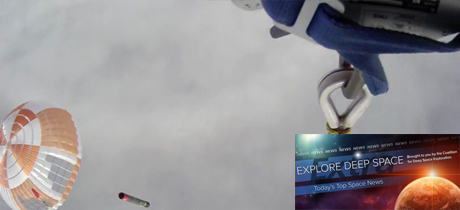In Today’s Deep Space Extra… NASA seeks public comment on plans to return samples of the Martian surface to Earth. The Commerce, Justice, Science Subcommittee of the Senate Appropriations Committee holds a hearing today on NASA’s FY23 budget request.
Space Science
NASA wants your input on its Mars sample return project
Space.com (5.2): NASA will host two virtual public hearings this week, Wednesday at 3 p.m. EDT, and Thursday at 8 p.m. EDT, on plans to return samples of the Martian surface gathered by the Perseverance rover, which landed in Jezero Crater on February 19, 2021. NASA is partnering with the European Space Agency (ESA) for the Mars Sample Return mission, a multi-spacecraft endeavor to return samples to Earth, perhaps as soon as 2033. Public input is to become part of an environmental impact assessment. NASA will also discuss the mission’s planetary protection measures, procedures intended to prevent exposing the Earth to potentially harmful Martian contamination.
China’s Zhurong travels over 1.9 km on Mars
Xinhuanet of China (5/2): In the nearly one year since it landed at Utopia Planitia, a vast northern hemisphere plain on Mars, China’s Zhurong rover has traveled 1.9 kilometers, or about one mile, collecting rock samples and imagery. The Chinese space administration also disclosed that lunar rover Yutu-2, or Jade Rabbit-2, has been working for 42 lunar days and moved 1,181 meters on the Moon’s surface. (Editor’s note: Xinhuanet is a Chinese government-owned news source).
Opinion
Act now on contingencies for Russian non-participation in ISS
The Space Review (5/2): NASA and the other agencies that support it must move quickly and comprehensively to identify and address the contingencies associated with a potential near term decision by Russia to withdraw from participation in the International Space Station (ISS), write engineers Srikanth Raviprasad and Steve Hoeser. The authors add that NASA should enhance progress toward replacing the ISS by providing non-monetary technical and NASA facility assistance to all U.S. commercial space station providers while working with other government stakeholders to remove bureaucratic and regulatory encumbrances that could hamper the establishment of U.S. commercial space habitat industry. The authors are concerned that recent demands from Russia threaten the safety of the ISS, people on Earth, and the cooperative mission objectives, including the transition to commercial space facility operations.
Other News
Senate Appropriations Subcommittee hearing on FY2023 NASA budget request, May 3, 2022, DC, 10:00 am EDT
Spacepolicyonline.com (5/2): The Commerce, Justice, and Science Subcommittee of the Senate Appropriations Committee will hold a hearing today at 10:00 am EDT in the Dirksen Senate Office Building on the FY2023 budget requests for NASA and the National Science Foundation. The hearing will be webcast on the committee’s website. So far only NASA Administrator Bill Nelson is listed as a witness.
Rocket Lab launches smallsats, catches but drops booster
SpaceNews.com (5/2): Rocket Lab attempted to demonstrate the recovery of an Electron rocket’s first stage for reuse on Monday evening by catching it in mid-air with a helicopter following the launch of the two-stage rocket from New Zealand with 34 small satellites. The recovery attempt occurred about 15 minutes after the launch at 6:49 p.m. EDT, with the first stage descending under parachute. As the stage was descending toward the Pacific Ocean, a piloted Sikorsky S-92 helicopter maneuvered close enough to snag a parachute line with a hook. However, the rocket stage was soon released when the pilot experienced forces different from those that had emerged during previous testing. The rocket stage descended into the ocean waters, where it was recovered.
Space Force selects 125 industry proposals for on-orbit servicing technologies
SpaceNews.com (5/2): SpaceWERKS, the technology division of the U.S. Space Force has selected 125 commercial companies for the initial phase of Orbital Prime, an effort to develop technologies to clean up space debris and provide other space services. Each participant will receive $250,000 to begin their development activities. Those eligible include small businesses, academic, and nonprofit institutions. To be eligible for selection under the Small Business Technology Transfer (STTR), businesses must be at least 51% U.S. owned and operated. The work has to be performed in the U.S. The initial phase spans 150 days and could lead to awards of up to $1.5 million for continuing development. The long-term goal is to select one or more teams in two years for the in-space demonstration of an on-orbit servicing, assembly, and manufacturing technology able to carry out functions such as the repair and refueling of existing satellites, removal and recycling of orbital debris, and manufacturing of products in space.
Ground-based radar could be one of our best tools against asteroids, new decadal survey finds
Space.com (5/3): According to the new decadal survey by the National Academies, one of the best tools to help protect the planet against the impact of near-Earth objects (NEOs) like asteroids is ground-based planetary radars. The decadal survey, in which researchers look ahead for the next ten-plus years, calls for further development of radar systems to aid in planetary protection by imaging newly discovered NEOs. Those images could help determine the probability and severity of a potential impact. Several such projects are in the works by the National Radio Astronomy Observatory (NRAO), which operates telescopes across the globe, and the Green Bank Observatory (GBO) in West Virginia.

